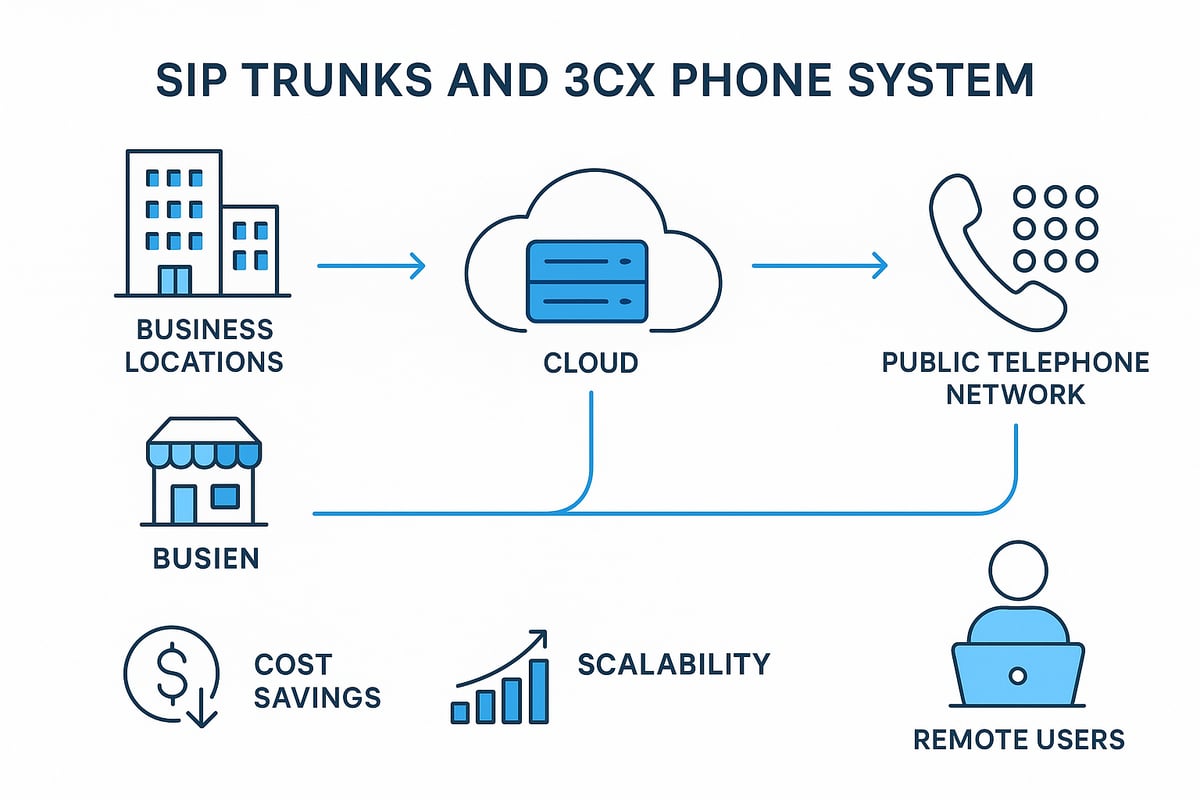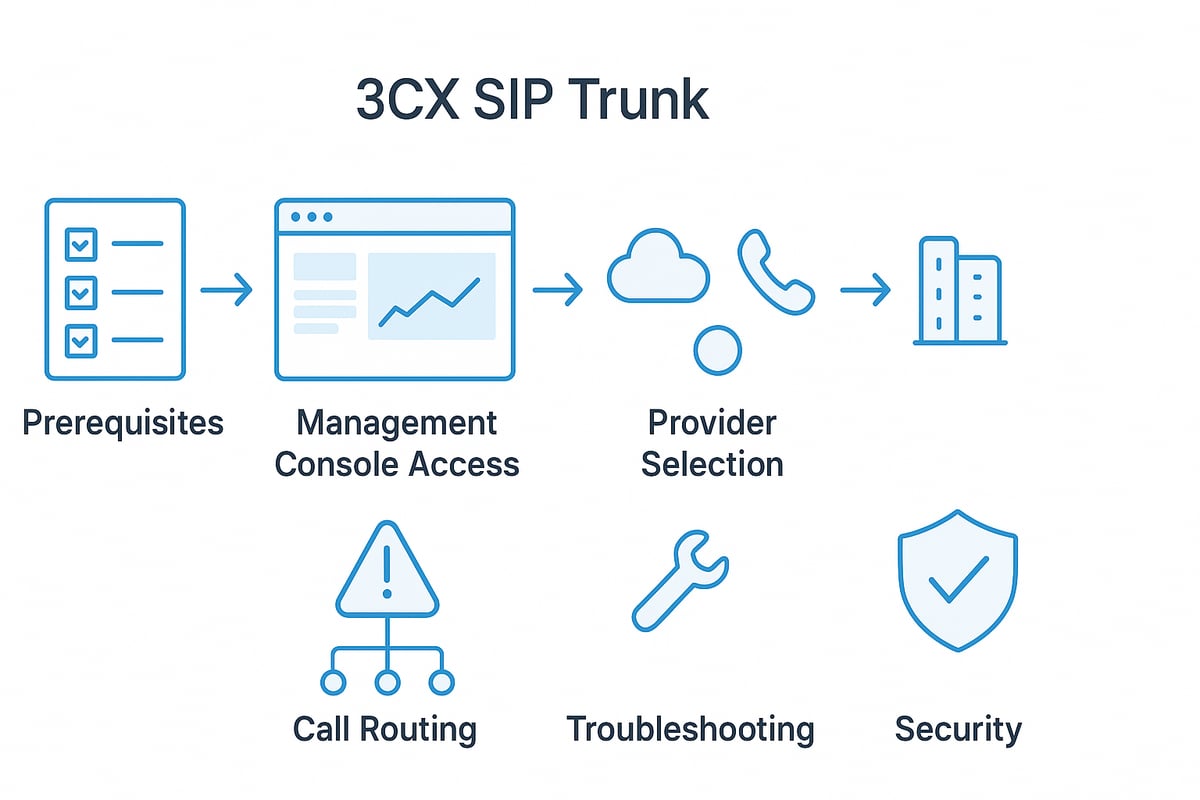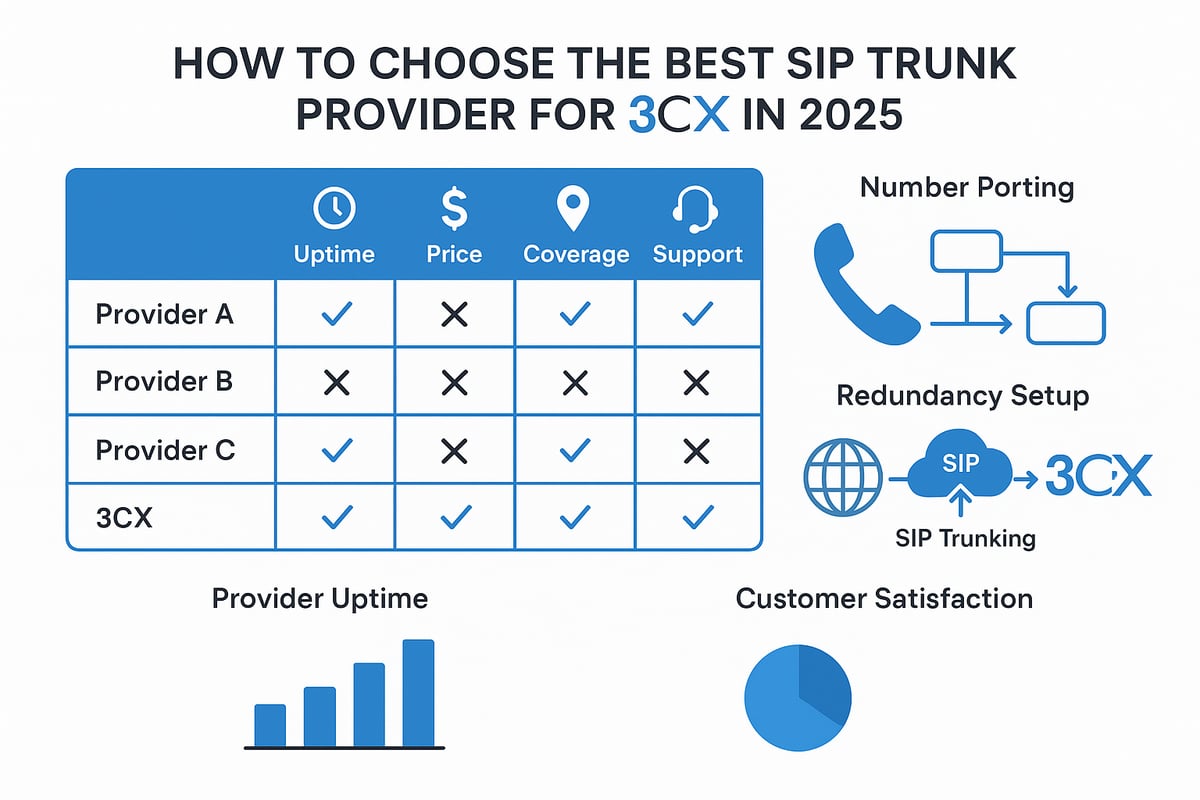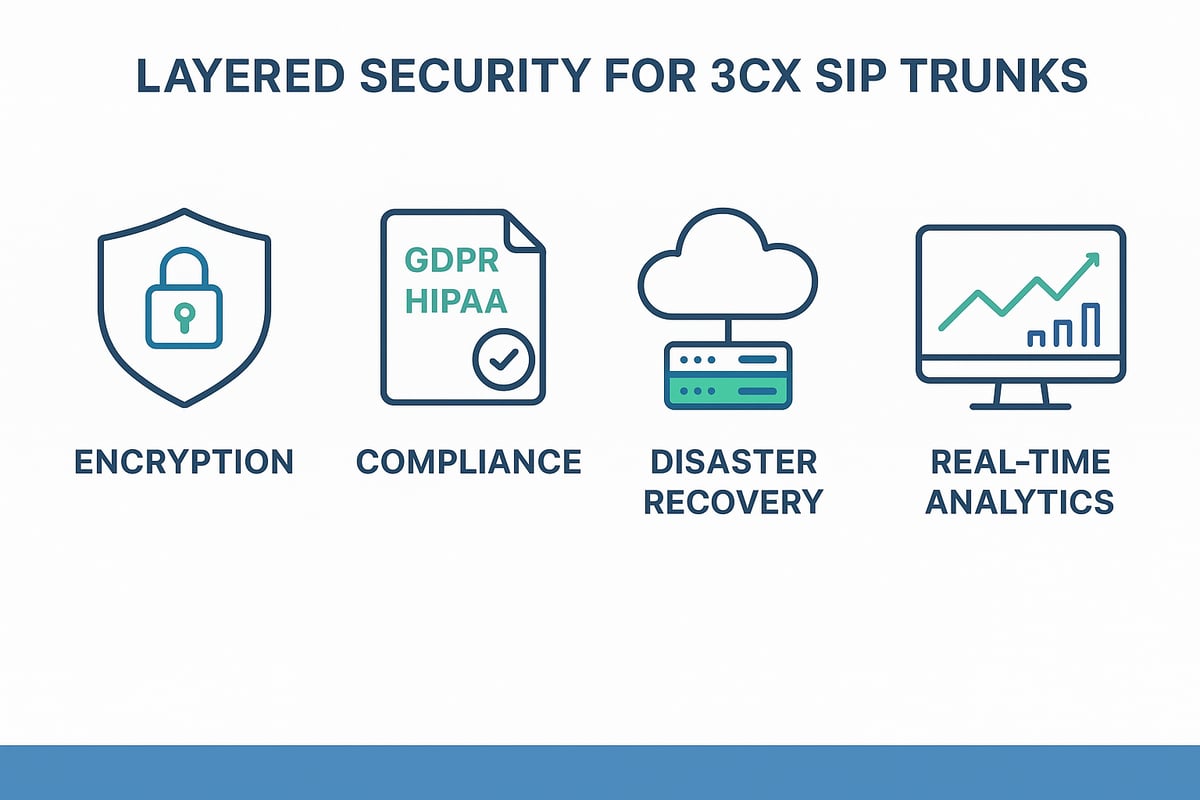3CX SIP Trunk Guide: Everything You Need to Know (2025)
Master 3CX SIP trunk setup, provider selection, security, and troubleshooting with this 2025 guide. Optimize costs, reliability, and business communications today.
Redaction
18/10/2025, 12:30:00In 2025, SIP trunks are essential for modern businesses adapting to remote and hybrid work environments. Leading systems like 3cx sip trunk empower organizations to reduce communication costs and increase flexibility. This guide will help you understand everything from setup to optimization, ensuring you make informed decisions for your business.
Explore how to integrate, secure, and scale your communication infrastructure with confidence. We will cover SIP trunk basics, 3CX integration, provider selection, security, troubleshooting, and the latest trends. Let’s future-proof your business communications together.
Understanding SIP Trunks and 3CX Fundamentals
Modern business communication relies heavily on digital voice solutions. To build a strong foundation, it's crucial to understand the basics of SIP trunks and how they interact with the 3cx sip trunk system. This section provides an essential overview, ensuring clarity for both technical and non-technical readers.

What is a SIP Trunk?
A SIP trunk acts as a digital pipeline for voice communication, replacing traditional phone lines with Internet-based connections. Unlike PSTN lines, SIP trunks allow businesses to make and receive calls using VoIP technology, offering greater flexibility and cost savings.
Key terms include:
- DID (Direct Inward Dialing): Assigns individual phone numbers to users.
- Channel: Represents a single concurrent call.
- SIP endpoint: The device or application registered to the SIP trunk.
Switching to SIP trunks can save the average business 30 to 50 percent on telephony costs (TechTarget). For a deeper dive into the basics, see SIP phone system basics.
Overview of 3CX Phone System
The 3CX phone system has evolved from a simple PBX to a unified communications platform. It offers features such as call routing, video conferencing, and team messaging. The 3cx sip trunk integration allows seamless connection to various VoIP providers, making it suitable for both small businesses and large enterprises.
Currently, over 600,000 businesses worldwide trust 3CX for their communication needs (source: 3CX official data). Its compatibility with SIP trunks is a key reason for its widespread adoption.
How 3CX and SIP Trunks Work Together
The 3cx sip trunk acts as a bridge between your internal phone system and the public telephone network. When a call is made, it routes through the 3CX PBX to the SIP trunk, which then connects to external numbers.
This setup supports multiple SIP trunks for redundancy and failover. Integration with tools like CRM software and Microsoft Teams further streamlines business workflows. Multi-site organizations can unify communication across locations using 3cx sip trunk configurations.
Key Benefits of Using SIP Trunks with 3CX
Pairing 3cx sip trunk solutions with the 3CX system brings several advantages:
- Lower telephony costs and predictable monthly billing
- Enhanced reliability, including disaster recovery options
- Effortless scaling for remote and hybrid teams
- Centralized management and detailed analytics
- Ability to support global operations with local phone numbers
These benefits make the 3cx sip trunk an attractive choice for organizations aiming for efficiency and growth.
Common Use Cases and Industries
The 3cx sip trunk is widely used in:
- Call centers managing high call volumes
- Remote teams needing flexible communication
- Multi-location businesses seeking unified systems
Industries such as healthcare, finance, retail, and education rely on these solutions to meet their daily communication demands.
Setting Up a 3CX SIP Trunk: Step-by-Step Guide
Setting up a 3cx sip trunk is a strategic move for any business aiming to modernize communications. This step-by-step guide walks you through the process, from initial requirements to advanced optimization, ensuring a reliable and secure VoIP experience.

Pre-Setup Requirements and Checklist
Before configuring your 3cx sip trunk, ensure you meet all prerequisites. Start with supported hardware, such as a compatible server or cloud instance. The 3CX software should be up to date, ideally the latest stable release. Check your network for adequate bandwidth - VoIP calls require low latency and sufficient upload/download speeds.
Security is crucial. Configure firewalls to allow SIP and RTP traffic, and plan Quality of Service (QoS) to prioritize voice packets. Make sure your SIP trunk provider is on 3CX’s supported list for seamless integration. Review licensing to confirm you have the correct 3CX version and SIP trunk channel count.
For deeper insight into VoIP PBX integration, see the VoIP PBX systems explained article. This foundational knowledge will help you avoid common pitfalls when setting up your 3cx sip trunk.
Step 1: Accessing the 3CX Management Console
Begin by logging into the 3CX Management Console using your administrator credentials. This web-based dashboard provides centralized access to all 3CX settings. Once inside, locate the “SIP Trunks” menu on the left sidebar.
The 3CX v20 interface is user-friendly and organized. Click “Add SIP Trunk” to start the configuration process. The console is also where you’ll manage extensions, call routing, and monitor system health. Consistent access to this portal is essential for ongoing management of your 3cx sip trunk.
Step 2: Adding a New SIP Trunk
In this step, choose your country and select a provider template from the dropdown. Templates streamline the setup by auto-filling common parameters. If your provider isn’t listed, opt for “Generic SIP Trunk” and enter the details manually.
You’ll need to input the SIP server address, authentication credentials, and assign DID numbers. When configuring your 3cx sip trunk, accuracy is key. Double-check all entries to ensure successful registration. This step sets the foundation for reliable inbound and outbound calling.
Step 3: Configuring SIP Trunk Settings
Fine-tune your 3cx sip trunk by setting outbound caller ID, selecting preferred codecs (such as G.711 or Opus for HD voice), and specifying the maximum number of simultaneous channels. Decide whether the trunk requires registration or IP authentication.
Advanced settings include choosing the transport protocol (UDP, TCP, or TLS) and configuring NAT or STUN/TURN for networks behind firewalls. For optimal voice quality, match codec settings with your provider’s recommendations. Proper configuration here ensures your 3cx sip trunk delivers clear and secure calls.
Step 4: Routing Incoming and Outgoing Calls
Efficient call routing is vital for any 3cx sip trunk deployment. Map each DID to the correct extension, ring group, or call queue. Outbound rules determine which trunk is used for specific call types, such as local, mobile, or international.
Set priorities to enable automatic failover if your primary trunk is unavailable. You can also route calls based on time of day or caller ID. For example, direct after-hours calls to voicemail or a different team. Careful routing ensures your 3cx sip trunk supports business continuity and efficient call handling.
Step 5: Testing and Troubleshooting
After setup, thoroughly test your 3cx sip trunk. Make inbound and outbound test calls to verify audio quality and call flow. The 3CX console provides real-time logs and diagnostic tools for troubleshooting.
If you encounter issues like one-way audio or failed registrations, use tools like Wireshark to analyze SIP traffic. Common problems include incorrect firewall rules or misconfigured credentials. Addressing these early ensures your 3cx sip trunk operates reliably from day one.
Step 6: Optimizing for Performance and Security
Maintain peak performance and robust security for your 3cx sip trunk by enabling encryption with SRTP and TLS. Implement rate limiting to prevent abuse and set up fraud detection features offered by 3CX and your SIP provider.
Monitor trunk health and call quality using built-in analytics. Configure alerts for any downtime or unusual activity. Regular reviews and updates keep your 3cx sip trunk resilient against evolving security threats and ensure consistent voice quality for your business.
Choosing the Best SIP Trunk Provider for 3CX
Selecting the right 3cx sip trunk provider is one of the most important decisions for any VoIP deployment. With the right partnership, your business can enjoy clear calls, reliable uptime, and cost savings. Understanding what to look for ensures your 3cx sip trunk setup meets both current and future needs.

Key Evaluation Criteria
When evaluating a 3cx sip trunk provider, focus on several core factors:
- Compatibility: Ensure the provider is certified for seamless 3cx sip trunk integration.
- Pricing Models: Compare per channel, per minute, and unlimited plans.
- Global Reach: Look for providers offering local DIDs in your target markets.
- Support and SLAs: Reliable support and clear service level agreements are essential.
- Redundancy: Confirm the provider supports failover and high availability.
Assessing these criteria helps you narrow down the best fit for your 3cx sip trunk deployment.
Top SIP Trunk Providers for 3CX (2025)
The market for 3cx sip trunk providers continues to expand globally. Some leading options in 2025 include those with high uptime, broad coverage, and competitive rates. For a deeper dive, explore this Best VoIP solutions for business resource to compare top providers.
- Provider A: 99.99% uptime, North America and Europe, advanced fraud protection.
- Provider B: Excellent customer support, Asia-Pacific focus, flexible pricing.
- Provider C: Strong presence in Latin America, free number porting, analytics tools.
These providers are known for their robust 3cx sip trunk compatibility and reliability.
Comparing Features and Pricing
A side-by-side comparison makes it easier to evaluate 3cx sip trunk providers. Below is a sample comparison table:
| Provider | Setup Fee | Call Rates | Contract Terms | Uptime | Unique Features |
|---|---|---|---|---|---|
| Provider A | $0 | $0.012/min | Month-to-month | 99.99% | Fraud detection, APIs |
| Provider B | $25 | $0.010/min | Annual | 99.95% | Free porting, analytics |
| Provider C | $10 | $0.015/min | Month-to-month | 99.98% | Global DIDs, SMS |
Look for value-added features, such as number portability and detailed analytics, when comparing 3cx sip trunk options.
Porting Numbers and Migration Considerations
Migrating to a new 3cx sip trunk provider often involves porting your existing numbers. The process requires coordination to reduce downtime. Typically, porting takes 3 to 10 business days, depending on region and compliance requirements.
To minimize disruption, request a detailed timeline from your 3cx sip trunk provider. Ensure your provider complies with local regulations, such as emergency calling and data retention. Careful planning ensures a smooth transition for your organization.
Redundancy and Multi-Provider Strategies
For maximum uptime, many businesses deploy more than one 3cx sip trunk provider. This approach allows for failover if a primary trunk experiences issues.
- Load Balancing: Distribute traffic across multiple trunks.
- Cost Optimization: Route calls based on price or destination.
- Failover: Automatically switch to a backup trunk during outages.
A retail business, for example, might use two active 3cx sip trunk providers to ensure continuous service, even during maintenance or unexpected failures.
Security, Compliance, and Reliability in 3CX SIP Trunks
Protecting your 3cx sip trunk setup is vital for maintaining business continuity and safeguarding sensitive communications. As usage grows, so does the potential for cyber threats, regulatory scrutiny, and the need for reliable service. This section explores essential strategies to keep your 3cx sip trunk secure, compliant, and highly available.

SIP Trunk Security Best Practices
Securing your 3cx sip trunk should start with robust encryption and authentication. Always enable TLS and SRTP to encrypt signaling and voice streams, protecting calls from interception.
- Use strong, unique passwords for all SIP accounts.
- Restrict access through IP whitelisting and geo-blocking.
- Regularly update firmware and software to address vulnerabilities.
Fraud prevention is equally important. Monitor call patterns for unusual activity and set rate limits to prevent toll fraud attempts. By following these best practices, organizations can confidently rely on their 3cx sip trunk for secure business communications.
Compliance and Regulatory Requirements
Compliance is a non negotiable aspect of any 3cx sip trunk deployment. Organizations must adhere to regulations such as GDPR for data privacy, HIPAA for healthcare, and local telecom rules.
- Ensure support for emergency calling (E911, 112) as required by law.
- Configure call recording in line with regional data retention policies.
- Maintain audit trails for all call activity.
3CX offers features that help meet these requirements, including encrypted call recording, access controls, and compliance-ready reporting. Businesses should review their industry regulations and configure their 3cx sip trunk accordingly to avoid penalties.
Ensuring High Availability and Disaster Recovery
Reliability is a cornerstone of the 3cx sip trunk experience. To prevent service interruptions, implement SIP trunk failover and backup routes. Use redundant providers or data centers for critical operations.
- Deploy both cloud and on premise instances for resilience.
- Set up real time monitoring and automatic alerts for trunk failures.
- Schedule regular disaster recovery drills.
For example, financial firms often rely on automatic trunk switchover to ensure seamless communication during outages. To learn more about the reliability advantages, read about SIP Trunking Benefits for Businesses.
Monitoring and Analytics
Continuous monitoring ensures your 3cx sip trunk performs at its best. Use built in tools to track call quality metrics, such as MOS scores, jitter, and latency.
- Analyze call volume and usage trends with detailed reports.
- Set up notifications for performance dips or outages.
- Leverage analytics to proactively detect and resolve issues.
Proactive monitoring not only supports SLA compliance but also helps identify areas for optimization. By making analytics a core part of your 3cx sip trunk management, you can ensure consistent quality and reliability for your organization.
Advanced Features, Integrations, and Optimization Tips
Modern businesses expect more than just voice from their phone systems. The 3cx sip trunk solution unlocks a suite of advanced features to streamline communications and enhance user experience. By leveraging these capabilities, organizations can boost efficiency and deliver a more professional customer journey.
Leveraging 3CX Advanced SIP Trunk Features
With a 3cx sip trunk, you gain access to powerful features that go beyond standard calling. These include:
- Call queuing to manage high inbound volumes efficiently.
- Interactive Voice Response (IVR), allowing callers to route themselves to the right department.
- Call recording for training and compliance.
- Fax over IP (T.38 support) for secure document transmission.
- SMS integration, enabling text notifications and two-way messaging.
For instance, a customer support IVR can direct calls to specific teams, while VoIP fax integration tips can help you set up reliable faxing over SIP. These features are configurable within the 3CX management console and can be tailored to fit any business workflow.
Integrating 3CX with Other Business Tools
A major strength of the 3cx sip trunk platform is its integration capability. Businesses can connect 3CX with:
- CRM systems like Salesforce and HubSpot for automatic call logging and customer data pops.
- Helpdesk tools such as Zendesk for seamless ticket creation.
- Microsoft Teams and Office 365, unifying telephony with collaboration apps.
For example, when a support call arrives, 3CX can log the interaction in your CRM and display customer details to the agent instantly. This integration ensures all communication data is centralized, providing a holistic view of customer interactions and improving service quality.
Optimizing Call Quality and Network Performance
Delivering clear, uninterrupted calls is vital. The 3cx sip trunk system supports optimization through:
- Bandwidth management to prioritize voice traffic.
- Quality of Service (QoS) settings on routers and switches.
- Codec selection (e.g., G.711 for office, Opus for remote teams) to balance quality and bandwidth use.
Here’s a quick table comparing codecs:
| Codec | Bandwidth Usage | Audio Quality |
|---|---|---|
| G.711 | High | Excellent |
| G.729 | Low | Good |
| Opus | Variable | High/Flexible |
For remote offices, using Opus can significantly improve resilience to network fluctuations, ensuring your 3cx sip trunk delivers reliable communication wherever your team works.
Scaling SIP Trunks for Growth
As your business expands, the 3cx sip trunk scales effortlessly. You can:
- Add channels to handle more simultaneous calls.
- Purchase additional DIDs for new departments or locations.
- Deploy 3CX across multiple sites with centralized management.
For example, an e-commerce company can increase channel capacity during seasonal peaks and reduce it afterward. This flexibility allows organizations to optimize costs while ensuring sufficient capacity. The centralized dashboard makes it easy to manage settings, monitor usage, and implement changes across all branches.
Future Trends in SIP Trunking and 3CX (2025 and Beyond)
Looking ahead, the 3cx sip trunk ecosystem continues to evolve. Key trends include:
- AI-powered analytics for real-time call insights and transcription.
- Cloud-based SIP trunks enabling rapid deployment and global reach.
- Enhanced security protocols to address emerging threats.
Predictive call routing, driven by AI, will become standard, helping businesses improve response times and customer satisfaction. For insights on adoption rates and market growth, see the SIP Trunking Industry Trends: 2025 Market Growth & Forecast Analysis. Staying informed about these trends ensures your communication strategy remains future-proof.
Troubleshooting Common 3CX SIP Trunk Issues
Even with a well-configured 3cx sip trunk, technical issues can disrupt business communications. Understanding how to identify and resolve the most common problems ensures your phone system remains reliable and efficient.
Diagnosing Registration and Connectivity Problems
Frequent registration failures or connectivity drops are often the first sign of a 3cx sip trunk issue. These problems can stem from several causes:
- Incorrect SIP credentials or authentication errors
- Network misconfiguration, including NAT or firewall restrictions
- SIP ALG (Application Layer Gateway) interfering with signaling
- ISP outages or blocked ports
To troubleshoot, verify the SIP username and password in the 3CX management console. Ensure required ports (such as 5060 UDP/TCP) are open on your firewall. Disable SIP ALG if present, as it may disrupt SIP traffic. Use 3CX Activity Log or the SIP Trace tool to monitor registration attempts and analyze error codes.
If issues persist, test connectivity from a different network to rule out local restrictions. Consistent monitoring helps keep your 3cx sip trunk stable.
Audio Quality and Call Drop Issues
Audio problems, such as choppy sound or dropped calls, can frustrate users and impact productivity. Common culprits behind 3cx sip trunk audio issues include:
- Network congestion or insufficient bandwidth
- High jitter or packet loss
- Incorrect codec selection
- Firewall or NAT misconfiguration
To resolve these, prioritize VoIP traffic using Quality of Service (QoS) rules on your router. Monitor real-time bandwidth usage and perform network tests. In the 3CX settings, select a resilient codec like Opus or G.711 for optimal audio quality.
If you experience one-way audio, check your firewall and NAT settings, ensuring proper SIP and RTP port forwarding. Regularly reviewing call statistics in the 3CX dashboard helps maintain a high-quality 3cx sip trunk experience.
Resolving Call Routing and Numbering Errors
Call routing mistakes can cause calls to reach the wrong extension or fail entirely. With a 3cx sip trunk, these issues often involve:
- Incorrect DID mapping to extensions or queues
- Outbound rule conflicts or incorrect dial patterns
- Overlapping number ranges or misconfigured inbound rules
To troubleshoot, review the DID assignments and ensure each number is mapped to the intended destination. Test outbound calls using different patterns to confirm rule accuracy. Use the 3CX Call Flow Designer or test numbers to simulate various call scenarios.
Document changes and keep a clear record of routing rules. This approach helps identify misconfigurations quickly and keeps your 3cx sip trunk routing predictable.
When to Contact Your SIP Trunk Provider or 3CX Support
Some 3cx sip trunk issues require escalation to your SIP trunk provider or 3CX support team. Consider reaching out when:
- Persistent registration failures occur despite correct local configuration
- Widespread call drops or audio issues impact multiple users
- You encounter SIP error codes indicating provider-side problems (such as 403 Forbidden or 503 Service Unavailable)
- Number porting or provisioning delays extend beyond typical timeframes
Before contacting support, collect diagnostic logs and SIP traces from your 3CX system. Document the troubleshooting steps already taken. For further guidance, visit the official 3CX Support page.
Timely escalation ensures that your 3cx sip trunk remains reliable and your communication channels stay open.As you’ve seen throughout this guide, staying ahead in business communications means choosing solutions that are reliable, scalable, and future ready - especially with the ongoing shift to remote and hybrid work. By understanding how 3CX and SIP trunks work together, you’re already a step closer to optimizing your infrastructure for efficiency and cost savings. If you’re ready to put this knowledge into action and experience truly seamless global communication with advanced features like real time analytics and dedicated support, let’s take the next step together. Start now!